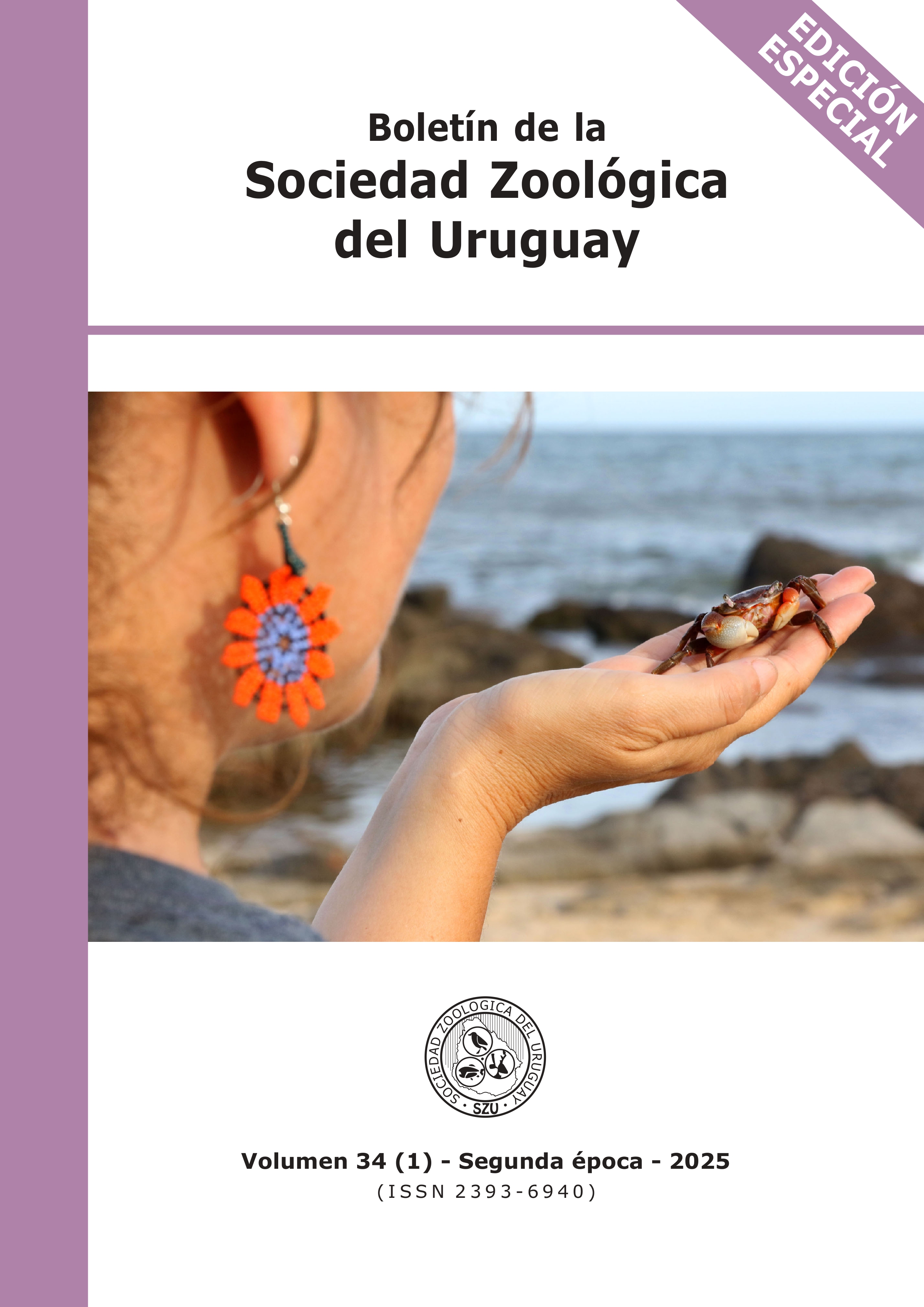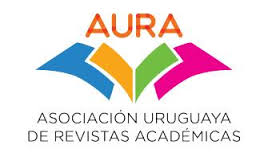ASSESSMENT OF POTENTIAL LURES FOR FRUIT FLIES (DIPTERA: TEPHRITIDAE) OF ECONOMIC IMPORTANCE IN URUGUAY
DOI:
https://doi.org/10.26462/34.1.9Keywords:
Ceratitis capitata, Anastrepha fraterculus, DAP, TrapsAbstract
Within Uruguay's fruit plantations, both Anastrepha fraterculus Wiedemann and Ceratitis capitata Wiedemann are reported as species of economic importance. These species are polyphagous and cause economic problems in fruit orchards. Currently, different control methods and techniques are combined, but in some cases, they are insufficient to prevent the damage caused by these species. We evaluated the attractiveness of different baits for fruit flies, as well as their selectivity toward non-target arthropods, in two peach and mandarin farms in southern Uruguay. Four treatments with three replicates were evaluated: diammonium phosphate (DAP), torula yeast (PBX®), torula yeast 'type B' and Cera Trap®/Plustrap®. Captured arthropods were separated into three groups: tephritids, beneficial and other. Tephritids were sexed, dissecting females to determine the presence of developed ovaries. All treatments were effective in capturing young females of C. capitata, while captures of A. fraterculus were very low. Captures of beneficial arthropods were relatively low, with DAP capturing the highest number. Lastly, torula yeast 'type B' was the one that captured the greatest number of non-target insects.
Downloads
References
Allwood, A.J., Leblanc, L., Tora Vueti, E., & Bull, R. (2001). Fruit fly control methods for Pacific Island countries and territories. Pest advisory leaflet, 40, 11-17.
Arroyo, F.T., Fairfield, S., García-Galavis, P.A., Santamaría, C., Pérez-Romero, L.F., & Daza, A. (2013). Control de la mosca mediterránea de la fruta (Ceratitis Capitata Wiedermann) en ciruelo ecológico mediante trampeo masivo. Retrieved 23 august 2024 from https://issuu.com/horticulturaposcosecha/docs/130406_ceratitis_arroyo
Bentancourt, C.M., Scatoni, I.B., & Morelli, E. (2009). Insectos del Uruguay. Montevideo: Facultad de Agronomía.
Braham, M. (2013). Trapping adults of the Medfly Ceratitis capitata and non target insects: comparison of low-cost traps and lures. Tunisian Journal of Plant Protection, 8(2), 107-118.
Buenahora, J. (2015). Un método alternativo de control para las moscas de las frutas: trampeo masivo. INIA. Retrieved from http://www.ainfo.inia.uy/digital/bitstream/item/10695/1/sad-745-p.23-27.pdf
Buenahora, J., & Otero, A. (2012). Aportes al manejo de Mosca de la Fruta mediante trampeo masivo. Eficiencia de distintos tipos de trampas para el trampeo masivo de Mosca de las frutas en Uruguay, Ceratitis capitata (Wiedemann). INIA. Retrieved from http://www.ainfo.inia.uy/digital/bitstream/item/9910/1/SAD-752.-p.77-80.pdf
Buenahora, J., & Otero, A. (2013). Eficiencia de distintos tipos de trampas utilizadas en el trampeo masivo de Mosca de las frutas en Uruguay (Diptera: Tephritidae). 2do. año de evaluación. INIA. Retrieved from http://www.ainfo.inia.uy/digital/bitstream/item/10559/1/sad-716-p.-13-23.pdf
Calvo, M.V., Duarte, F., Delgado, S., Mello Garcia, F.R. & Scatoni, I.B. (2024). Bases for management of
fruit flies (Diptera: Tephritidae) in Uruguay. In F.R. Mello Garcia Editor (Ed.), Management of Fruit Flies in the Americas (1 ed., pp. 539-555). Springer, Cham.
Cotoc-Roldán, E.M., Vela-Luch, W.C., Estrada-Marroquín, C., & Hernández-Pérez, R. (2021). Evaluación de trampas para el seguimiento de Ceratitis capitata (Wiedemann, 1824) (Diptera: Tephritidae) en el cultivo del café en Acatenango, Guatemala. Revista chilena de entomología, 47(1), 147-156.
Delgado, S.A., Calvo, M.V., Duarte, F., Borges, A., & Scatoni, I.B. (2022). Food Attractants for mass trapping of fruit flies (Diptera: Tephritidae) and its selectivity for beneficial arthropods. Florida Entomologist, 105(3), 185-193.
Delgado, S., Duarte, F., Yakimik, N., & Calvo, M.V. (2024). Contribution of commercial traps to the efficiency and selectivity of mass trapping attractants for tephritids. International Journal of Pest Management, 1-9.
Di Rienzo, J.A., Casanoves, F., Balzarini, M.G., Gonzalez, L., Tablada, M., & Robledo, C.W. (2010). InfoStat (Versión 2020). Centro de Transferencia InfoStat. http://www.infostat.com.ar
Duarte, F., Calvo, M.V., Delgado, S.A., Garcia, F.R., & Scatoni, I.B. (2021). Spatio-temporal distribution of Anastrepha fraterculus and Ceratitis capitata (Diptera: Tephritidae) captures and their relationship with fruit infestation in farms with a diversity of hosts. Florida Entomologist, 104(4), 297-306.
Ghanim, N.M., El-Sharkawy, R.A., & El-Baradey, W.M. (2021). Influence of mixing ammonium acetate and di-ammonium phosphate on their attraction to the peach fruit fly Bactrocera zonata (Diptera: Tephritidae) under field conditions. Egyptian Journal of Plant Protection Research Institute, 4(2), 230-239.
Hafsi, A., Harbi, A., Rahmouni, R., & Chermiti, B. (2015). Evaluation of the efficiency of mass trapping of Ceratitis capitata (Wiedemann) (Diptera: Tephritidae) in Tunisian citrus orchards using two types of traps: Ceratrap® and Tripack®. Acta Hortic, 1065, 1049-1056.
Hernández-Ortiz, V., & Aluja, M. (1993) Listado de especies del género neotropical Anastrepha Schiner (Diptera: Tephritidae) con notas sobre su distribución y plantas hospederas. Folia Entomológica Mexicana, 88, 89-105.
Instituto Nacional de Investigación Agropecuaria (2019). Nuevas híbridos de mandarina de maduración tardía. Nuevas variedades de naranjas liberadas. https://inia.uy/Documentos/P%C3%BAblicos/INIA%20Salto%20Grande/2019_2025_Actividades/2019/2019_08_28_MandarinasTardias/Jornada%20de%20presentaci%C3%B3n%20de%20variedades%20tard%C3%ADas%202019.pdf
Instituto Nacional de Tecnología Agropecuaria (s.f.). CARTILLA PRÁCTICA Nº 1. LA MOSCA DE LA FRUTA (Ceratitis capitata). https://repositorio.inta.gob.ar/xmlui/bitstream/handle/20.500.12123/6565/INTA_CR%20Cordoba_EEA%20Manfredi_Triadani%20O%20E_La_mosca_de_las_frutas.pdf?sequence=1&isAllowed=y
Kouloussis, N.A., Mavraganis, V.G., Damos, P., Ioannou, C.S., Bempelou, E., Koveos, D.S., & Papadopoulos, N.T. (2022). Trapping of Ceratitis capitata using the low-cost and nontoxic attractant Biodelear. Agronomy, 12(2), 525.
Malavasi, A., Rohwer, G.G., & Campbell, D.S. (2019). Fruit fly free areas: strategies to develop them. In C. Calkins (Ed.). Fruit flies and the sterile insect technique (pp. 165-180). CRC Press.
Mangan, R.L., & Thomas, D.B. (2014). Comparison of torula yeast and various grape juice products as attractants for Mexican fruit fly (Diptera: Tephritidae). Journal of Economic Entomology, 107(2), 591-600.
Norrbom, A.L., Korytkowski, C.A., Zucchi, R.A., Uramoto, K., Venable, G.L., McCormick, J., & Dallwitz, M.J. (2012). Anastrepha and Toxotrypana: descriptions, illustrations, and interactive keys. https://www.delta-intkey.com/anatox/index.htm
Porcel, M., Campos, M., Ruano, F., Sanllorente, O., & Caballero, J.A. (2009). Incidence of the OLIPE mass-trapping on olive non-target arthropods. Spanish Journal of Agricultural Research, 7(3), 660-664.
Sabater-Muñoz, B., Tormos, J., De-Pedro, L., Harbi, A., Tur, C., Briasco, M., Verdú, M.J., & Beitia, F.J. (2012). Estrategias de control integrado de Ceratitis capitata en cítricos. Vida Rural, (353), 42-45.
Sadraoui-Ajmi, I., Benali, N., Soltani, A., Chaib, S., Limem, E., Jallouli, S., Boushih, E., Fajraoui, A., & Jemâa, J.M.B. (2022). Usage of agricultural DAP-fertilizer and Eucalyptus essential oils as potential attractants against the Mediterranean fruit fly Ceratitis capitata (Tephritidae). Journal of Asia-Pacific Entomology, 25(1).
Scatoni, I.B., Calvo, M.V., Delgado, S.A., Duarte, F., & Zefferino, E. (2019). Las moscas de la fruta (Diptera: Tephritidae) en el Uruguay. INIA. http://www.ainfo.inia.uy/digital/bitstream/item/13888/1/Inia-Fpta-81-proyecto-289-2019.pdf
Shelly, T.E., & Kurashima, R.S. (2016). Capture of Mediterranean fruit flies and melon flies (Diptera: Tephritidae) in food-baited traps in Hawaii. Proceedings of the Hawaiian entomological society, 48, 71-84.
Shelly, T., Kurashima, R., Nishimoto, J., & Andress, E. (2017). Capture of Zeugodacus cucurbitae (Diptera: Tephritidae) in traps baited with torula yeast solution versus cucumber volatile plugs. Florida entomologist, 100(1), 15-20.
Son, A.R., Suh, S.J., & Choi, D.S. (2019). Non-target insects captured in tephritid fruit fly (Diptera: Tephritidae) surveillance traps in South Korea: a survey-based study. Journal of Asia-Pacific Biodiversity, 12(1), 129-133.
Roh, G.H., Kendra, P.E., & Cha, D.H. (2021). Preferential attraction of oviposition-ready oriental fruit flies to host fruit odor over protein food odor. Insects, 12(10), 909.
Thomas, D.B. (2003). Nontarget insects captured in fruit fly (Diptera: Tephritidae) surveillance traps. Journal of Economic Entomology, 96(6), 1732-1737.
Triadani, C.O.E., & Bruxmann, E.G. (2019). La mosca de la fruta (Ceratitis capitata). INTA. https://www.mapa.gob.es/ministerio/pags/biblioteca/hojas/hd_1988_08.pdf
Uchida, G.K., Mackey, B.E., Vargas, R.I., Beardsley, J.W., Hardy, D., Goff, M.L., & Stark, J.D. (2006). Response of nontarget insects to methyl eugenol, cue-lure, trimedlure, and protein bait bucket traps on Kauai island, Hawaii, USA. Proceedings of the Hawaiian Entomological Society, 8, 61-71.
Vilajeliu, M., Batellori, L., & Escudero, A. (2007). Captura masiva para el control de Ceratitis capitata. Horticultura Internacional, 56, 46-52.











